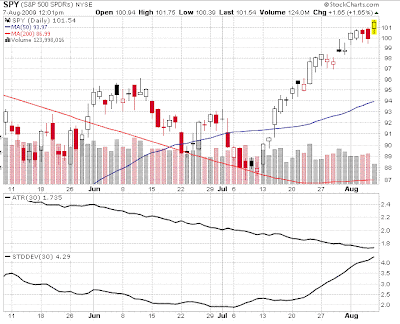Those folks that have been around options for any length of time, might have noticed the way in which options newsletters and course sellers report profits (but never losses :))from options.
The first trend goes something like:
...top-performing 2009 trades scored 844%, 416%, 390% and 227%
Is it possible? Of course it is. It might be true, it might accurately reflect the facts, but is it appropriate to report it in this way?
Firstly, big wins are nice, but on their own say nothing unless in context with a string of trades taken by the trader. The bottom line is that the sum of winning trades must exceed the sum of losing trades for there to be a profit at the end of the year. This is what's never reported on. This big outlier wins are important of course, but what is more important is the number and scale of losses in comparison. Mathematical expectancy is what's important.
The second point is the capital allocation to these option trades. If a stock trader allocates a $10,000 position size to each trade, how much capital should the trader allocate to a long option trade?
Anybody that buys $10,000 worth of options in place of $10,000 worth of stocks, probably should be committed; particularly if they are out of the money option punts.
Obviously if the trader uses some sort of position sizing algorithm based on capital at risk (fixed fractional or similar), the capital used in each trade will be commensurately smaller with the option trade.
Put these two points together and those huge percentage wins take on an entirely different perspective. The question should be: What is the return on capital with reasonable risk control in place?
But that doesn't make for good advertising copy does it?
The second trend is the practice of annualizing profits. For example:
Net Premium: 2.70
Net Return: 3.8%Annualised Return: 87%
If the trader could guarantee similar net returns with no gaps and possibility of losses, it might be a valid way of reporting losses.
But this is the real world, traders must deal with the reality of losing sometimes. Once again sums of wins versus sums of losses (AKA expectancy) applies. How many times does the trader win 3.8% and how many and what percentage losses does the trader suffer over the course of the year.
And on the niggly point of losses, should they also be reported on an annualized basis? That wouldn't make good advertising copy would it.
Imagine a 7% loss on a 4 week covered call annualized. That doesn't look so good. :(
The only thing important to any trader, whether trading options, stocks, or tiddly-winks, is the bottom line at the end of the year. That is, the return on the entire account. We trade options to hopefully improve that return over other methods of trading and investing, but there there is more to it than many vendors let on and more to it that what is reported in some blogs and options advertising.
I'm probably "preaching to the converted" mostly; obvious stuff to anyone who trades options seriously. It's still worth putting out there once in a while for new people coming in to Option Land to consider.





